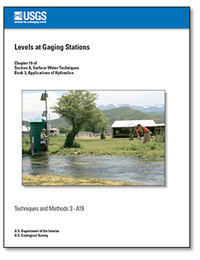Levels at Gaging Stations
Links
- Document: Report (5.74 MB pdf)
- Appendixes:
- Appendix (66.1 KB pdf) - Appendix A. Fixed-Scale Test Form
- Appendix (68.2 KB pdf) - Appendix B. Peg Test Form
- Appendix (189 KB pdf) - Appendix C. Level Notes Form
- Appendix (24.5 KB xlsx) - Appendix D. Historical Level Summary Form
- Download citation as: RIS | Dublin Core
Abstract
Operational procedures at U.S. Geological Survey gaging stations include periodic leveling checks to ensure that gages are accurately set to the established gage datum. Differential leveling techniques are used to determine elevations for reference marks, reference points, all gages, and the water surface. The techniques presented in this manual provide guidance on instruments and methods that ensure gaging-station levels are run to both a high precision and accuracy. Levels are run at gaging stations whenever differences in gage readings are unresolved, stations may have been damaged, or according to a pre-determined frequency. Engineer’s levels, both optical levels and electronic digital levels, are commonly used for gaging-station levels. Collimation tests should be run at least once a week for any week that levels are run, and the absolute value of the collimation error cannot exceed 0.003 foot/100 feet (ft).
An acceptable set of gaging-station levels consists of a minimum of two foresights, each from a different instrument height, taken on at least two independent reference marks, all reference points, all gages, and the water surface. The initial instrument height is determined from another independent reference mark, known as the origin, or base reference mark. The absolute value of the closure error of a leveling circuit must be less than or equal to 0.003√n ft, where n is the total number of instrument setups, and may not exceed |0.015| ft regardless of the number of instrument setups. Closure error for a leveling circuit is distributed by instrument setup and adjusted elevations are determined. Side shots in a level circuit are assessed by examining the differences between the adjusted first and second elevations for each objective point in the circuit. The absolute value of these differences must be less than or equal to 0.005 ft. Final elevations for objective points are determined by averaging the valid adjusted first and second elevations. If final elevations indicate that the reference gage is off by |0.015| ft or more, it must be reset.
Suggested Citation
Kenney, T.A., 2010, Levels at gaging stations: U.S. Geological Survey Techniques and Methods 3-A19, 60 p.
ISSN: 2328-7055 (online)
Table of Contents
- Preface
- Abstract
- Introduction
- Purpose and Scope
- Differential Leveling and Leveling Equipment
- Establishment of Gage Datum
- Frequency of Gaging-Station Levels
- Preparation for Running Levels
- Running Levels
- Office Procedures
- Auxiliary Data to be Obtained During Level Runs
- Summary
- References Cited
- Glossary
- Appendix A. Fixed-Scale Test Form
- Appendix B. Peg Test Form
- Appendix C. Level Notes Form
- Appendix D. Historical Level Summary Form
- Appendix E. Summary of Selected Requirements and Tolerances for Gaging Station Levels
| Publication type | Report |
|---|---|
| Publication Subtype | USGS Numbered Series |
| Title | Levels at gaging stations |
| Series title | Techniques and Methods |
| Series number | 3-A19 |
| DOI | 10.3133/tm3A19 |
| Publication Date | October 02, 2010 |
| Year Published | 2010 |
| Language | English |
| Publisher | U.S. Geological Survey |
| Publisher location | Reston, VA |
| Contributing office(s) | Office of Surface Water, Utah Water Science Center |
| Description | Report: viii, 60 p.; Appendixes A-D |
| Larger Work Type | Report |
| Larger Work Subtype | USGS Numbered Series |
| Larger Work Title | Section A: Surface-Water Techniques in Book 3: Applications of Hydraulics |
| Public Comments | This report is Chapter 19 of Section A: Surface-Water Techniques in Book 3: Applications of Hydraulics |
| Online Only (Y/N) | Y |
| Additional Online Files (Y/N) | Y |


